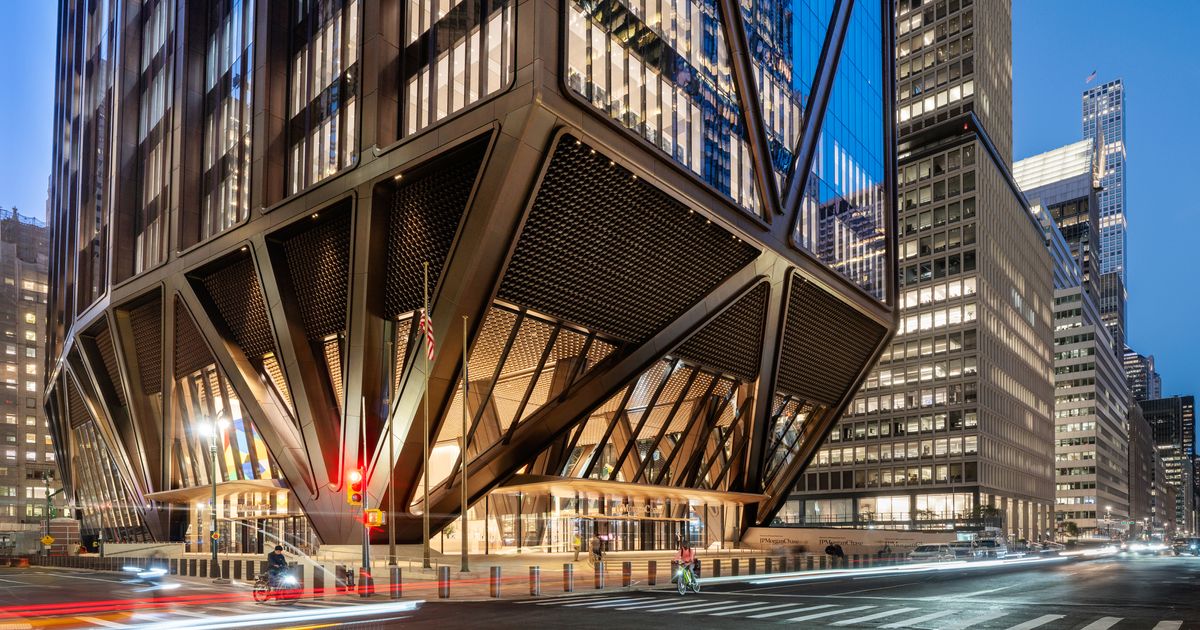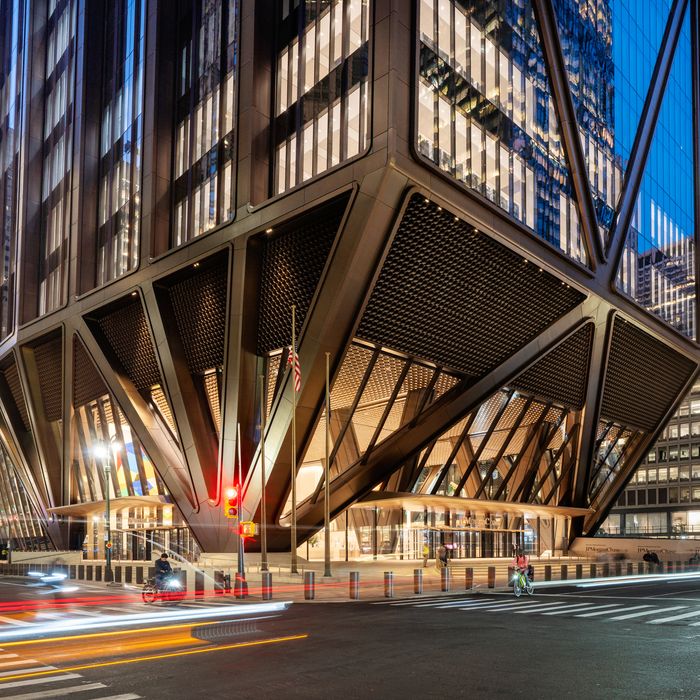
JP Morgan Chase’s new headquarters at 270 Park Avenue is a $3 billion altar to capital. Foster and Partners pulled the lobby back from the sidewalk to create privately owned public spaces and angled the walls outward to create canopies on all four sides.
Photo: Nigel Young/Courtesy Foster + Partners
If New York’s new mayor-elect wants to behold the forces of capitalism he’s up against, he can stand on the corner of Park Avenue and 48th Street and look up. That’s where Jamie Dimon, the CEO of JPMorganChase, has erected a $3 billion altar to capital that lords it over the Manhattan skyline with a nightly light show a quarter-mile above the street. This is a building that isn’t shy about its brawn; it reminds both users and passersby that the world it occupies isn’t built only on intangible bits of memory, ephemeral shares, credit, and cybercurrency, but also out of thick, hard, heavy metal and stone. The new headquarters of the world’s most lavishly capitalized bank is a physical manifestation of might, its bronzed steel structure zigzagging down the façade like lightning and spearing the street in Brobdingnagian vees.
Of course, 270 Park Avenue is an office building as well as a metaphor, the place where 10,000 of the company’s 24,000 New York employees will soon be spending their days with one eye on the terminal and the other on the clock. Dimon has been loudly insistent that workers must work where they work — be present, visible, trackable, well fed, and reliably caffeinated. He’s revoked the right of remote employment and made the new tower the centerpiece of a multiblock corporate campus. He is, in effect, sculpting a chunk of the city to his priorities. And he is a loyal New York billionaire, the kind the next mayor needs but has also cast as the people’s nemesis. Park Avenue north of Grand Central Terminal is the zone where Jamie Dimon’s and Zohran Mamdani’s metropolitan visions collide.

The JP Morgan Chase headquarters at 270 Park contains the city’s highest office floors.
Photo: Max Touhey for JPMorganChase
Designed by Foster and Partners, the skyscraper is the latest but not the last of the luxury behemoths born of the East Midtown rezoning that passed City Council in 2017. That law was intended to resurrect midtown as one of the world’s great business districts by encouraging the construction of bigger, bulkier, costlier skyscrapers. Erecting JPMorgan’s new headquarters meant tearing down the Union Carbide building, a handsome example of midcentury modernism designed by SOM’s Natalie de Blois, which was doomed precisely because, like Foster’s successor, it was so well suited to its time. De Blois was one of the pioneers of pared-down, glass-skinned boxes that reflected the era’s allegiance to efficiency, transparency, and unsentimental modernity. JPMorgan bought and renovated the building, then judged it obsolete: too-low ceilings, too many columns, too few bathrooms (especially for women), and not nearly enough space for the company’s updated needs. It required a tower that was more spacious, more seductive, and, crucially, capable of switching to its own source of power at a millisecond’s notice if the electrical grid went down.
Foster’s creation attracts attention by being ostentatiously conservative. The bronze trim on its surface flares in the late-afternoon sun, giving the tower a mellow, bourbon-colored glow. The angled beams and canopies are as aerodynamically sculpted and swathed in supple skin as a fleet of custom Mercedes-Benzes. Norman Foster, master of high-tech corporate elegance on a giant scale, is an architect fond of pointing out that “in a medieval cathedral, the structure is the architecture and the architecture is the structure.” The JPMorgan Tower lives up to that ideal by giving the diagonal bracing a visible role. Angled shafts of steel skewer the office floors. At certain nodes along its height, the floor slabs cut off, creating a glass-walled aerial cavern with a 50-foot vault. The diamond-shaped frames on the exterior are lit like logos, and at each avenue entrance, two leaning columns meet in the middle to form a triumphal arch. The structure looks at once muscular and precariously balanced, like a ballet dancer en pointe. That’s not just for effect: The supports had to thread through a stack of train tunnels, without touching the tracks, before reaching bedrock.
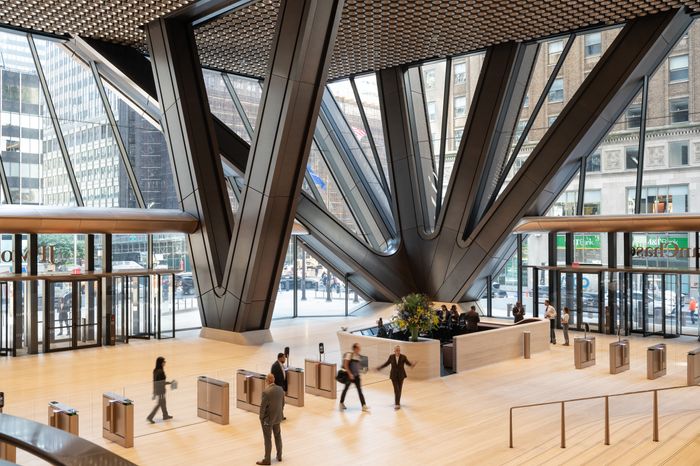
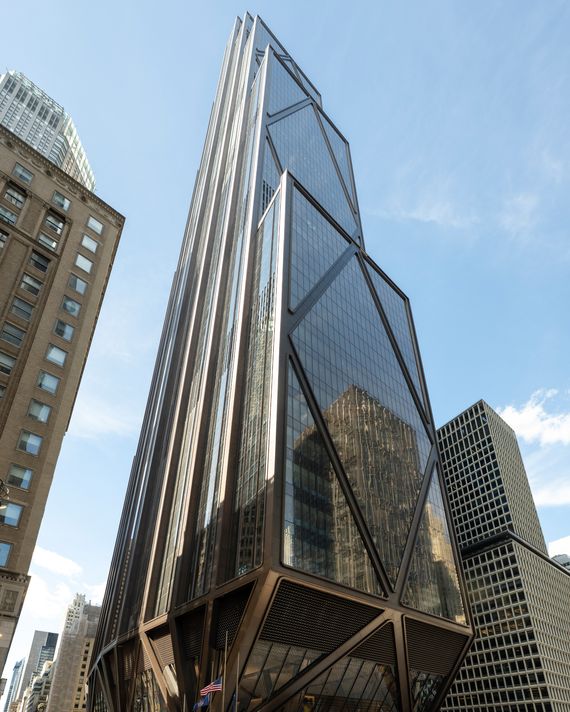
From left: Great steel vees shift the tower’s weight to columns that thread through the train tracks below. Photo: Nigel Young/Courtesy Foster + PartnersDiagonal bracing on the exterior makes the façade part of the structure. Photo: Nigel Young/Courtesy Foster + Partners
From top: Great steel vees shift the tower’s weight to columns that thread through the train tracks below. Photo: Nigel Young/Courtesy Foster + Partne… more
From top: Great steel vees shift the tower’s weight to columns that thread through the train tracks below. Photo: Nigel Young/Courtesy Foster + PartnersDiagonal bracing on the exterior makes the façade part of the structure. Photo: Nigel Young/Courtesy Foster + Partners

With its avenue-to-avenue views, 50-foot ceilings, and massive Gerhard Richter paintings, the lobby reflects the bank’s imperial ambitions.
Photo: Nigel Young/Courtesy Foster + Partners
Most monumental architecture — palaces, pyramids, and corporate headquarters — justifies vanity, makes power appear eternal, and bolsters those who struggle against frailty and doubt. Banks have a special responsibility to be architecturally reassuring. Nobody wants to entrust their life savings to a flimsy or whimsical-looking institution, which is one reason for the regular recurrence of the Greek temple. Something about a Corinthian column radiates trustworthiness. (Which is odd, really, since most of antiquity’s religious structures fell down and its gods were driven by caprice and emotion.) Neoclassicism isn’t Norman Foster’s thing, but theatrical sturdiness is. In the 1980s, when he was asked to design “the best bank building in the world,” he came up with the HSBC headquarters in Hong Kong, a stack of prefabricated modules suspended from steel masts and braced by an exoskeleton. Four decades later, his firm’s work is smoother and so confident in its high-tech modernity that he doesn’t mind slipping in a wry neoclassical reference. The massive twin elevator shafts in the lobby are clad in convex lengths of marble, as if to say, Do you still long for ye olde fluted columns? Fine — I’ll flute the whole damn core. Twice over!
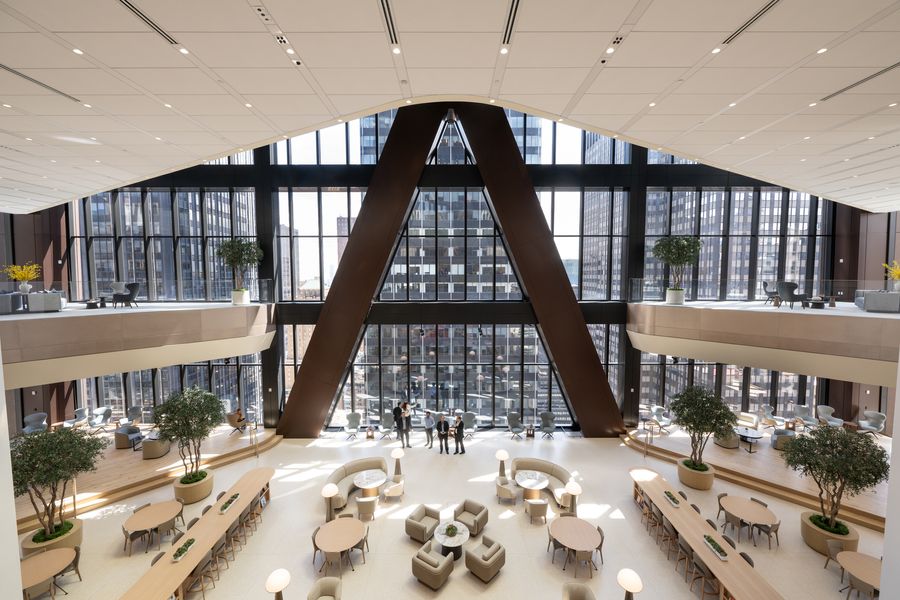
A multilevel space called the Exchange includes a convertible auditorium where CEO Jamie Dimon can address the troops.
Photo: Nigel Young/Courtesy Foster + Partners
Up in the shaft, the grandiose, ceremonial scale gives way to more ordinary floors of offices designed by Gensler with an abundance of common spaces and upholstered alternatives to the chair-desk-terminal combo. Dimon’s back-to-work policy may be coercive, but the building provides plenty of seductive reasons to acquiesce: an abundance of Alp-clean air, soft lights, armchair nooks that are comfortable but not soporific, a circular sky bar with imperial views, a paralyzing array of food options, and Guinness on tap. There’s also an assortment of private spaces in which to meditate, breastfeed, melt down, and get it together before returning to your desk to pollinate the world with cash. Oh, and art — lots of art, most of it collected by the former Chase CEO David Rockefeller but some of it new and huge. On the Madison Avenue side, Maya Lin has flanked the entrance with two fake slabs of Central Park schist that don’t do much to adorn the façade but will surely tempt free-solo rock climbers to beat security guards to the top. Safely inside the Park Avenue entrance are two giant-economy-size Gerhard Richter abstractions in metallic paint.
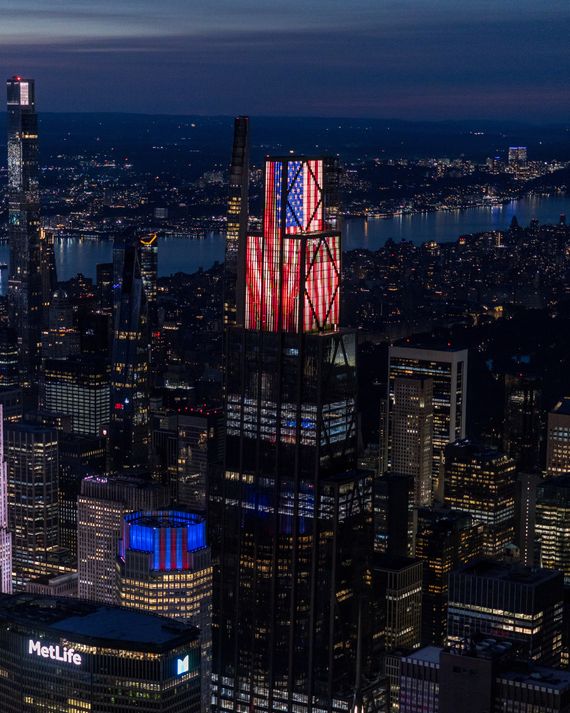
The top 300 feet are a vacant support for a nightly light show.
Photo: JPMorganChase
All these hospitable touches no doubt help retain talent and court clients, but they’re not what gives the tower its charisma or its starring role in the theater of New York. The architects’ challenge was to shape a tower that was at once muscled and airy, a private fiefdom that appears invitingly public. At the top, the crown earns its place on the skyline with 300 feet of empty structure that could almost pass for a spire from one angle, or a stack of office floors from another, but in fact exist to host a glittering nightly show of light art by Leo Villareal. The JPMorgan tower isn’t the tallest on the midtown skyline — it just looks like it is. Down at street level, 270 Park announces itself not only with size but also with avenue-to-avenue views, right through the raised lobby. Its rushed commuters might find it hard to miss the abundance of sumptuous detail, including a 50-foot-high ceiling gridded with circular light fixtures reminiscent of Marcel Breuer’s old Whitney Museum (now reopened as Sotheby’s).
Foster’s most effective move toward disarming a potentially resentful public was to pull the lobby’s glass walls in from both Madison and Park Avenues, leaving generously landscaped areas, then let the building spread out overhead. But instead of making do with an ordinary cantilever that might feel like a highway viaduct, Foster angled the exterior wall so it becomes a canopy, keeping the rain out but letting light flow down into the plaza with its café tables, fountain, and built-in benches. That gesture of noblesse oblige represents a philosophical challenge to Mamdani because it invites New Yorkers to shelter beneath JPMorgan’s canopy and lounge in JPMorgan’s sliver of park. Adding privately owned public space in exchange for extra height is a concept enshrined in city law, and the bank would probably not have bothered with it otherwise. Even so, the Tower of Dimon, sitting at the intersection of finance and real estate, twines itself literally through the physical city, from the train tunnels below to the sidewalk and up to the skyline — and through its urban culture, too. From footing to crown, the bankers have used architecture to beam a message to the incoming mayor: Demonize us at your peril. Mamdani’s city of street vendors and Queens bodegas might seem incompatible with Dimon’s glinting Manhattan, but they’re really interdependent elements of the same complex metropolis.
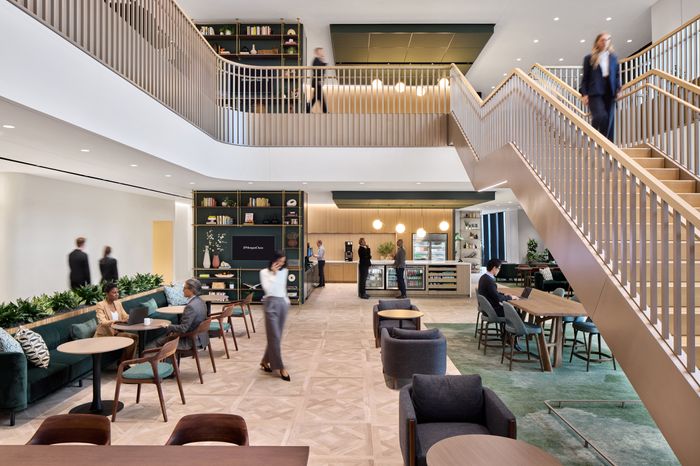
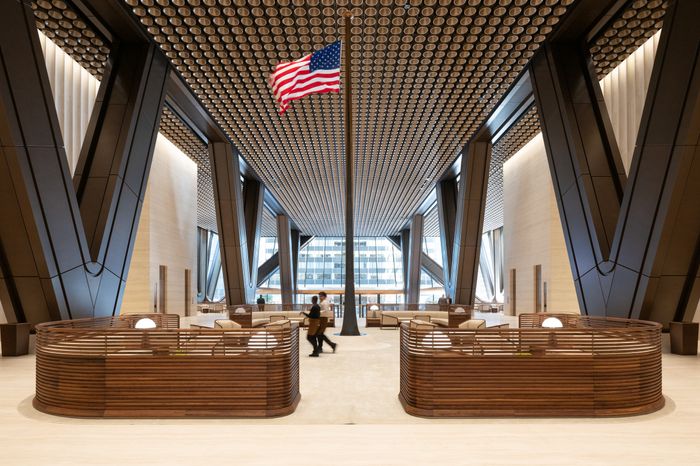
From left: Employees have a choice of pub fare, food trucks, white-tablecloths, and quick bites scattered throughout the building. Photo: Garrett Rowland/Courtesy of GenslerThe twin elevator cores in the raised lobby are clad in fluted marble. Photo: Nigel Young/Courtesy Foster + Partners
From top: Employees have a choice of pub fare, food trucks, white-tablecloths, and quick bites scattered throughout the building. Photo: Garrett Rowla… more
From top: Employees have a choice of pub fare, food trucks, white-tablecloths, and quick bites scattered throughout the building. Photo: Garrett Rowland/Courtesy of GenslerThe twin elevator cores in the raised lobby are clad in fluted marble. Photo: Nigel Young/Courtesy Foster + Partners
Related

